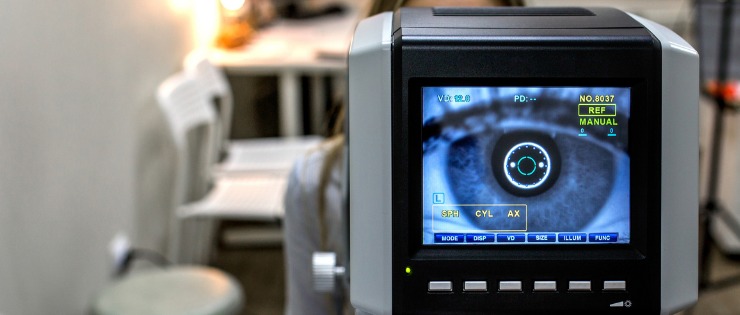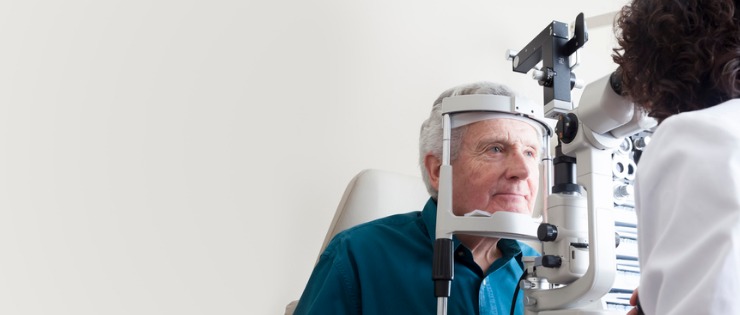
All parts of our bodies age, it’s part of growing old but our eyes are particularly vulnerable to deterioration. Age related macular degeneration is a sinister disease because early symptoms are impossible to detect. You may have just learned that you are someone close to you has been diagnosed with AMD. Many people are not aware of this condition so this article is intended to give people an overview of age-related macular degeneration. It covers:
This information is general in nature. For specific advice, we recommend you speak with your eye care professional.
What is Age Related Macular Degeneration (AMD)?
Age related macular degeneration is an eye condition that causes loss of vision in people over the age of 50. The macular is part of the eye located near the centre of the retina that helps with sharp, central vision.
AMD (sometimes also called AMRD) makes it difficult to see objects that are straight ahead so it impacts on driving, reading, writing, cooking and other close work. The centre of the field of view can become blurry, distorted and dark.

Macular Degeneration Causes & Risk Factors
While age is the biggest risk factor for AMD, other factors that increase risk include:
Smoking: The risk of AMD doubles if you smoke
Family history/genetics: Having a family history of AMD places you at higher risk. Around 20 genes have been identified as affecting the risk of developing AMD
Race: Caucasians are more at risk of developing AMD
Blood Pressure: A high blood pressure can increase the risk of AMD
Weight: Being obese places you at a higher risk
Diet: A lack of nutrients reaching the retina is also a possible cause of AMD
Light: Exposure to too much ultraviolet light (UV) is a risk factor
Macular Degeneration Symptoms
Most people don’t know they have AMD in its early stage as there are no symptoms of macular degeneration at first. It’s not until the intermediate or late stage that someone with AMD will notice any changes to their vision.
The symptoms of macular degeneration include:
Gradual or instant loss of vision
Straight lines appear distorted
Dark blurry areas
Whiteout in the centre of your vision
Detecting Macular Degeneration
Before symptoms begin, AMD can be detected with a comprehensive dilated eye exam. An optician places drops in the eye to dilate (widen) the pupils. A magnifying lens is used to look at the retina and optic nerve for signs of AMD. Yellow deposits beneath the retina known as drusen are a normal part of aging however larger quantities may indicate AMD.
Pigmentary changes under the retina and in the iris are another indication of AMD.
A testing tool, the Amsler grid, is a series of vertical and horizontal lines that can be used to test a person’s central visual field. Someone with AMD won’t see straight lines, they will see wavy lines. The Macular Disease Foundation Australia recommends people over the age of 50 look at an Amsler grid at home weekly to check for early signs of AMD. For those people who have already been diagnosed with AMD or have early signs of the disease, they should use an Amsler grid every day to monitor progression.
The grid should be held at a normal reading distance in a well lit room. Cover one eye and use the other eye to focus on the centre dot. Repeat with the other eye. This allows any potential issues in individual eyes to be revealed. If the lines appear wavy or bent or there are dark or empty spaces appear on the grid, see your doctor.

The Three Stages of AMD
There are three stages of AMD – early, intermediate and late.
Early Stages of AMD
While vision loss is not usually noticed by someone with early stage AMD, it is possible for an optician to diagnose the condition.
Intermediate Stages of AMD
Even the intermediate stage of AMD may not be noticed by someone with the condition. Most people don’t experience any symptoms at this stage although some people may notice some vision loss. It will be obvious to an optician during an eye examination however because there will be large drusen present and/or pigment changes in the retina.
Late Stages of AMD
Vision loss is obvious to someone with late stage AMD because the macular has been damaged. There are two types of late stage AMD – geographic atrophy (dry AMD) and neovascular (wet AMD).
Geographic atrophy occurs when light sensitive cells in the macular and tissue beneath the macular gradually break down causing vision loss. The dry type of AMD is most common. Nine out of 10 people with macular degeneration have the dry type.
The symptoms of geographic atrophy include:
Experiencing difficulty going from bright to low light situations
Trouble reading as only parts of letters may be visible
Difficulty recognising people’s faces
Colours appear washed out
Hazy vision
Straight lines appearing wavy
Needing more light
Neovascular AMD occurs from abnormal blood vessels growing underneath the retina. Fluid and blood can leak from these vessels damaging the macular. The damage can be swift and severe.
The symptoms of neovascular AMD include:
Dark spot in the centre of your vision
Distorted vision
Colours appear washed out or different in each eye
Objects appear to be different in size for each eye
If you experience these symptoms, see your doctor without delay.
Age-Related Macular Degeneration Treatment
There is limited treatment for AMD in the early stages- it’s a case of prevention is better than the cure. To reduce the chance of AMD progressing, don’t smoke, exercise regularly and eat a nutritious diet including green leafy vegetables. Later stages of AMD can be treated with drug and laser therapies.
Supplements
A research trial by the National Eye Institute conducted a study on whether taking high dose vitamins and minerals can slow progression of the disease. Known as the Age Related Eye Disease Study (AREDS), a nutritional formulation containing vitamin C, vitamin E, beta-carotene, zinc and copper was trialed in 2001.
A second trial was conducted in 2006 called AREDS2 with an improved formulation. By then beta-carotene was known to increase the risk of lung cancer in smokers so the second formula replaced the beta carotene with omega-3 fatty acids and antioxidants. In 2013 results of the second trial were released. Researchers recommended the original AREDS formulation be used with the beta-carotene removed and the proteins lutein and zeaxanthin added.
The supplement was responsible for slowing the progression of AMD for people who are in the intermediate stage in one or both eyes or in the late stage in one eye. While the supplements can’t cure AMD or reverse the damage, the risk of progression was reduced by 20-25% and delayed vision loss. Speak to your doctor before taking supplements.
Drug and Laser Treatments
To stop the growth of new blood vessels in the eye, an anti vascular endothelial growth factor (VEGF) drug may be used. It stops the VEGF protein in retina cells from working. The anti VEGF treatment can be used on cases on wet AMD, diabetic maculopathy and macular oedema.
Photodynamic therapy (PDT) uses a photosensitive intravenous drug with a low, long duration infrared laser to destroy blood vessels that are leaking in the eye.
The heat from a thermal laser is used to disrupt the disease by burning leaking blood vessels under the macular. Sealing the blood vessels means there is less fluid buildup under the centre of the retina. It is only a temporary treatment for half of the patients who experience a recurrence of leaking blood vessels and there is some damage to the macular. It’s no longer a commonly used treatment method.
Other Degenerative Eye Diseases
AMD isn’t the only age-related eye condition. Elderly people should monitor their vision and have regular eye checks for the following:
Glaucoma
Glaucoma is caused by high pressure inside the eye or poor circulation causing damage to the optic nerve which carries images from the eye to the brain. Glaucoma can cause blindness but it usually develops slowly and shows few symptoms early on.
The risk factors for glaucoma include:
Family history
Past eye injury
High eye pressure or low blood pressure
Diabetes
Farsightedness or nearsightedness
African or Hispanic ancestry

Cataracts
Another common eye problem in later life is cataracts. The lens of the eye becomes cloudy and vision is blurred for people with a cataract. One in eight Australians over the age of 80 will develop glaucoma. Around 50% of people who have glaucoma don’t know they have it because it can’t be self-detected and there are no symptoms in the early stage. But if detected early, treatment can stop any significant loss of vision.
The risk factors for cataracts include:
Too much exposure to sunlight
Past eye injury or surgery
Family history
Smoking
High cholesterol or high blood pressure
Smoking
Symptoms of cataracts can include:
Double vision with one eye
Difficulty seeing at night
Halos around lights
Blurry, clouded vision
Colours are faded or yellowed
If the symptoms impact on daily life too much a surgeon can replace the cloudy lens and with a clear lens implant.
Diabetic retinopathy
Blood vessels can grow in the retina and leak fluid or bleed as a complication of ucontrolled diabetes. If left untreated, diabetic retinopathy will damage the retina which transforms light into images. The extra pressure of the additional blood vessels causes scar tissue to build up and can cause the retina to detach.
Symptoms of diabetic retinopathy include:
Blurry vision
Black spots or holes in vision
Inability to see colours
Loss of central vision most noticeable when reading or driving
Laser treatment can be used to seal or destroy leaking blood vessels in the retina. However, the treatment can make it more difficult to see colours and night vision is impacted. Maintaining normal blood sugar and blood pressure levels is the best way of protecting eyes from any further damage.
For Early Detection Get Regular Eye Checks
With so many age-related eye conditions undetectable in the early stages, it is important that people have regular eye checks. For adults under the age of 60 with no family history or eye problems, a two yearly exam is fine but for people over the age of 60 an annual exam is recommended.
A regular eye test will allow your optician to check if there have been any changes in your eyes since the last test and see if you are in the early stages of any eye conditions or diseases. If a problem is detected, monitoring and treatment may reduce or slow down the loss in vision.
Like all body parts, eyes degenerate as we get older but rather than just brush it off as another part of growing old, take preventive measures to look after your eyes. Eat a healthy diet, do some exercise, don’t smoke and have an annual eye exam to protect your eyesight.
Living With AMD
If you are living with AMD and looking for more information or want to know how to support a loved one with AMD there are organisations dedicated to eye health and support for people with visual impairment, such as: